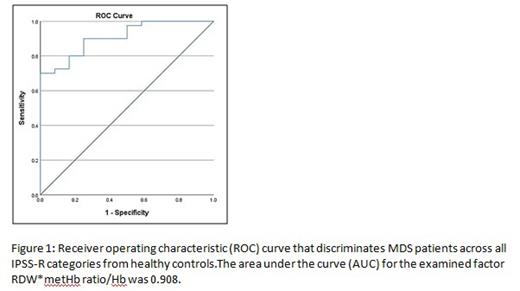PV and KT as well as VP and MA contributed equally
Introduction: Myelodysplastic syndromes (MDS) are clonal hematopoietic disorders characterized by ineffective hematopoiesis, different degree of cytopenias, and increased risk of transformation to AML. Anemia constitutes a main clinical manifestation contributing to increased morbidity and mortality. It is currently managed with red blood cell (RBC) transfusions, erythropoiesis stimulating agents (EPO), and recently,with luspatercept. The latter enhances late stage erythropoiesis and is indicated for Ring Sideroblasts (RS) MDS resistant to EPO. Several lines of evidence suggest that MDS pathophysiology is associated with structural and functional distortions of mature red cell (RBCs), such as hemolysis that in rare instances include acquired lesions like hemoglobinopathies and membranopathies.These abnormalities add variability to the clinical MDS phenotypes and could serve as biomarkers for early diagnosis or monitoring. However, they have been scarcely investigated.
Patients and methods: We examined 40 MDS patients and 12 healthy sex- and age-matched controls. According to the IPSS-Rrisk stratification system, 8 patients were High Risk (HR) and 32 patients Low Risk (LR)MDS, of whom 8 under EPO (EPO-LR) and 4 under luspatercept (luspatercept-LR) treatment. None of them had received RBC transfusions in the past three months. Following full blood count analyses and RBC fractionations, we measured hemolysis (basal, osmotic, mechanical, and oxidative), eryptosis and oxidative stress, as well as the antioxidant capacity of the plasma through spectrophotometry,fluorometry and flow cytometry.
Results: Compared to controls, the cohort of MDS patients was characterized by anemia (Hb 10.7 vs 13.6g/dL) and significantly higher HDWand RDW (17.5 vs. 13.4%) indexes. RBCs exhibited signs of eryptosis (RBC calcium concentration 7063±1443 vs. 6027±1541 RFU/mg; PS surface exposure 0.61±0.45 vs. 0.33±0.17%) and oxidative stress (higher metHb/oxyHb ratio; membrane-bound hemichromes 45.0±15.3 vs. 30.2±13.3). About 18% of the patients presented spontaneous hemolysis. Clinical severity correlated with the levels of cytopenias, and oxidative hemolysis. Anemia correlated positively with the age, and the levels of membrane-bound hemichromes, eryptosis and intracellular reactive oxygen species (ROS). According to ROC analysis, the combination of RDW, metHb/oxyHb ratio, and total Hb concentration is predictive of MDS, across all IPSS-R categories(area under the curve: 0.908; Figure 1).
We then examined the subgroups of MDS patients. Apart from the RDW, the LR-MDS subgroup exhibited on average normal RBC features, in opposite to the more anemic and thrombocytopenicHR-MDS subgroup that showed pathologically increasedresistance to osmotic hemolysis, intracellular calcium (7946±1917 vs. 6026±1541RFU), and metHb/oxyHb ratio (18.5±7.3 vs. 10.4±3.9%), when compared to controls. Of note, similar abnormalities were observed in the EPO subgroup that further showed reticulocytosis, PS externalization, and membrane-bound hemichromes(p<0.05) Compared to the non-treated subgroup, the EPO-LR had lower WBC counts, but higher RDW, PS exposure (0.75±0.44 vs. 0.41±0.26%) and resistance to osmotic stress, aspreviously reported in other EPO-treated patients.Luspatercept-LR had higher WBC and PLT counts but exhibited EPO-like effects on RBCs, including pathological resistance to osmotic/mechanical lysis, ROS concentration (1347±453 vs. 960±160 RFU), Hb oxidation, and PS exposure (1.05±0.60 vs. 0.41±0.26%), compared to the non-treated LR subgroup.
Conclusion: MDS RBCs are highly heterogeneous in terms of volume and Hb concentration and present signs of oxidative stress and eryptosis. Consequently, these easily accessible markers could be an accessory tool to the MDS diagnosis.In the context of ineffective hematopoiesis and increased apoptosis of precursor erythroid cells,the LR-MDS patients exhibit minimal RBC abnormalities. On the other hand, the expansion of BM blasts and the lower level of apoptosis in HR-MDS seem to affect RBCs in a hemoglobinopathy-like manner in terms of Hb oxidation, eryptosis signaling, and membrane ion channels. EPO and luspatercept treated LR patients exhibit improved cytopenias but worse RBC physiology most probably attributed to clinical factors like RS phenotype.
Disclosures
No relevant conflicts of interest to declare.


This feature is available to Subscribers Only
Sign In or Create an Account Close Modal